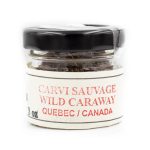Excerpt from Ari’s Top 5 enews
A Salute to Really Wild Wild Rice
If you’ve never tried really wild wild rice–I mean the real thing, not the commercial replica—you’re in for a revelatory eating experience!
Really wild wild rice is one of the best examples I can come up with of the difference between treating what we work with with dignity, or relating to it merely as a means to a financial end. Everything about really wild wild rice speaks to dignity. The oral traditions of Native American tribes make clear that for many millennia wild rice was the single most important food of the people of the Upper Midwest and central Canada. In the Ojibwe language, the name is manoomin, meaning “good berry,” but early English and French explorers related it instead to the grains they’d grown up with; the French, for example, called it folle avoine, or “crazy oats.” The English settled on “wild rice.” Many years ago, in an effort to treat the authentic article with the dignity it deserved, I began to call it “really wild wild rice” when I realized that what was once solely a wild grass in nature is today endangered by cultivation and, more recently, climate change. Two hundred years ago, all wild rice was wild; today something like ninety-plus percent of what is being sold on the market as “wild rice” is actually cultivated.
Really wild wild rice was in this part of the world very much what corn was in the American Southwest—culturally significant, much revered, economically essential, and also oft eaten. The annual, late August, wild rice harvest, said 19th-century historian Eva Lips, was “the decisive event of the year, of the total economic life and with it, life itself.” Ojibwe writer Jim Northrup explained, “Wild rice … is the annual gift from the Creator.” To this day, Northrup writes, “It appears at every celebration or sorrowful gathering.” When we eat it, we’re honoring tradition and paying proper homage to the history of the Native peoples of the region who have eaten manoomin for millennia. And we know that it is harvested in a way that’s appropriate and regenerative for the ecosystem and that pays an equitable price to those who do the hard work to gather it.
To cook it, you can simply boil it in salted water like pasta until it’s tender—it takes only about fifteen to twenty minutes max. By contrast, cultivated “paddy rice” usually takes about an hour, if not longer. This is no joke—the cultivated stuff takes forever to cook and it doesn’t taste very good when it’s done, either. I still laugh out loud every time I see Jim Northrup’s “recipe” for paddy rice: “First, find a baseball-sized rock. Add that to the water/paddy rice mixture that is boiling. Cook until the rock is soft; that means your rice is almost done.”
Mo Frechette, co-managing partner at Zingerman’s Mail Order for about thirty years now, says, “The flavor is absolutely stunning. It’s mild but extremely complex, with woody, green and grassy flavors mixed in with nutty, yeasty, earthy notes. Never overpowering, it’s the kind of flavor kids love too.” If you like pasta, rice, or other grains, I really encourage you—in the interest of both dignity and deliciousness—to make this really wild wild rice part of your regular cooking routine. Great as a side dish, or as a main course. Partners super well with bacon and also with autumn mushrooms. Great for breakfast too topped with butter and sprinkled with maple sugar or syrup. Super fine with fish, chicken, pork, or really just about anything!



